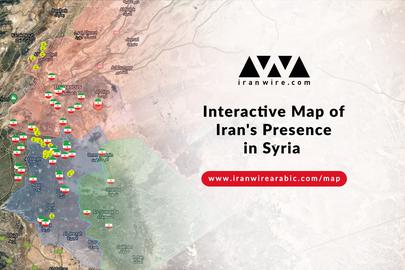IranWire's interactive map of Iran's presence in Syria is a key part of its ongoing policy to expose Iranian media disinformation, and shows where Iranian militias are based in Syria, providing a brief explanation of each location and its significance.
***
Syrian President Bashar Al-Assad has denied the presence of any Iranian forces in Syria, and described Iran’s role in the country as offering military expertise rather than military action.
Speaking to the Russian news agency Sputnik on October 7, al-Assad said: "We do not have Iranian forces, and this is very clear. They support Syria, they send military experts, they work with our forces on the ground, and they are present with the Syrian army."
Military Experts or Field Commanders?
What Al-Assad described in the interview as "military experts" are, in fact, field military commanders from the Iranian Revolutionary Guards’ Quds Force, who head its militias and carry out its orders. The salaries of the militias' fighters are paid by Iran, according to sources in contact with IranWire. These sources have also identified Iranian militia locations in Syria, which have been put together as an interactive map, part of a project led by IranWire's Arabic team.
The map, an important part of the site's ongoing policy to expose Iranian media disinformation, shows the whereabouts of Iranian militias in Syria, and provides a brief explanation of each location and its significance.
The locations the map identifies were provided to IranWire by Syrians alarmed by Iran’s presence, as well as by our own correspondents and private sources, some of them Lebanese, and other individuals close to the Islamic Revolutionary Guards Corps. Each piece of information has been crosschecked with content posted by Iranian soldiers on social media in Persian, information circulated by local residents on social media, and articles published in local media. IranWire has obtained information on more than 90 locations, but we have only published those locations that can be fully crosschecked and verified by our sources.
To verify the authenticity of the locations, the IranWire Arabic team also sought the assistance of a former Syrian diplomat in Washington, Bassam Barbandi, who agreed to be a project consultant. Barbandi follows Iran-related issues closely and is familiar with the Syrian locations identified.
The project will be completed in three phases. First, locations in the southern region will be published, followed by the central region, and finally the northern region.
Iranian and Russian Media Disinformation
On July 7, 2017, the United States, Russia, and Jordan reached a ceasefire agreement regarding southwestern Syria.
At the time, Russian Foreign Minister Sergey Lavrov said the agreement included the regions of Daraa, Al-Quneitra, and Al-Suwayda'.
The agreement came as a result of unannounced meetings between the United States and Russia regarding Syria, meetings that took place over a period of months. The agreement provided for the withdrawal of Iranian militias to a distance of 40km from the Jordanian border and the Golan Heights; a three-stage withdrawal of Syrian regime forces from the city of Daraa; the enforcement of a ceasefire; and the establishment of 5km buffer zones with Syrian opposition factions in the area around Daraa.
The presence of Iranians in Syria's southern regions at the locations highlighted on the map shows that the Russians have been unable to uphold their agreement with the Americans in the south, which requires Iran to withdraw to a distance of between 40 and 60km from the borders.
Importance of Southern Region
The southern region is of great strategic importance to Iran, which seeks to find a foothold near the border with Israel. This would give Iran the upper hand if it is subject to an US-Israeli military campaign, according to Syrian diplomat Bassam Barbandi.
The Syrian diplomat added: "Iran also played a major role in motivating the Syrian regime to attack Daraa. This Iranian stance stems from the Astana Agreement, which represents the cornerstone of Russian-Iranian-Turkish cooperation to end the Syrian crisis in a way that preserves the interests of all three countries. From this standpoint, Russia agreed to give Turkey guarantees on the ground to ensure its security and achieve its objectives in Syria in the regions east of the Euphrates and Idlib. Consequently, Iran believes that Russia should give it the same security and strategic rights in the southern region in Syria, south of Damascus to the borders with Israel, in order to counter any US-Israeli military escalation against it and to strengthen its position in any upcoming talks regarding outstanding issues with the West."
The more international pressure on Iran increases and Israeli strikes target Iranian positions inside Syria continue, the more Iran will insist on intensifying its presence on the border with Israel. This in turn will void the Russian-sponsored agreement between local residents and the Syrian regime and will also necessitate a stop to what Iran considers a state of chaos in the south. Moreover, the Syrian regime always justifies Iran's actions by claiming that it is fighting terrorism.
In early December, during his meeting with new Syrian foreign minister Faisal Al-Miqdad, who traveled to Tehran for the talks, Iranian President Hassan Rouhani called on Damascus to "see the necessity of continuing to confront Israel until all the occupied territories, including the Golan, are liberated," while pledging to support Syria as a strategic ally. President Rouhani said: "Confronting the Zionist occupiers and terrorism is a common goal of the two peoples. We have no doubt that we must continue to resist until the end and eliminate terrorists."
Creation of Loyal Militias
Over the last few years, Iran has sought to build allied forces under several names and has expanded its military bases in the region close to Israel, "not caring or paying attention to what the Russians say or do in terms of agreements with the Israelis and the Americans, on the premise of 'if you cannot protect us from the Israelis, leave us to fight them alone,'" says Barbandi.
Barbandi further says that it is for this reason that the Iranians "established the 313 Shiite Military Brigade headed by Ibrahim Marji, based in Izra, which consists of approximately 1,200 fighters." He adds: "Linked to the Iranian Revolutionary Guards, the brigade's mission is to protect Iran's interests in the region, including strategic weapons stores in the southern region. In this way, the truce in the south is not in Iran's interests, seeking instead to extend its control over the southern borders in order to threaten Israel and maintain an upper hand to help to ease the economic and political blockade imposed on it by the West."
The military positioning of Iranian militias, however, does not reveal Iran's true presence, which precedes the protests that erupted in Syria in 2011 and runs much deeper than what is currently being discussed. In this way, Iran's presence is an incursion that can be crystallized in terms of political and military domination as well as economic, ideological, and cultural interference.
Muhammad Zaid Mastou is the editor-in-chief for IranWire Arabic
visit the accountability section
In this section of Iran Wire, you can contact the officials and launch your campaign for various problems

























comments